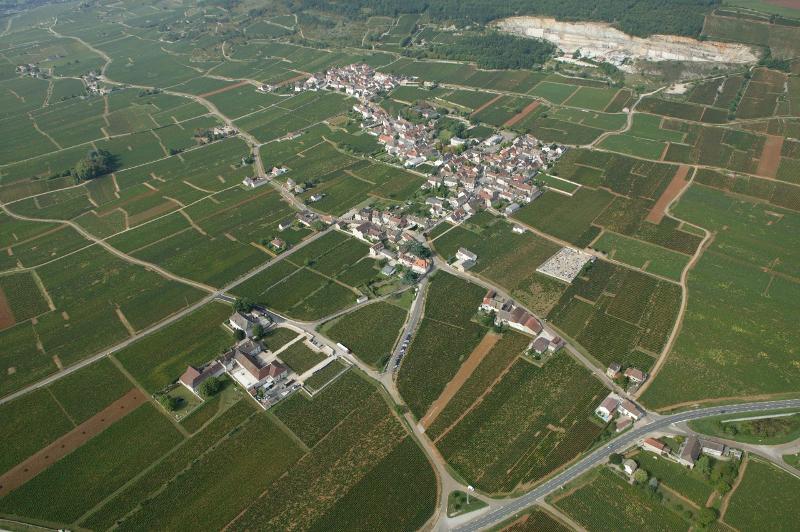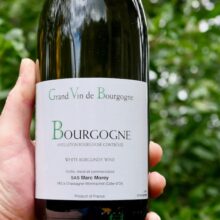
Winery
Domaine Marc Morey
Marc expanded on Fernand’s initial land purchases and began to bottle the estate’s wine production in 1937 under the name Domaine Fernand Morey. Marc Morey and his daughter Marie-Josephe, with her husband Bernard Mollard, continued the augmentation of the domaine, creating the estate as Domaine Marc Morey, a Societe Civile d’Exploitation (or family corporation) in 1977. Today, Sabine Mollard oversees the vineyards and winemaking.
Sabine Mollard arrived at Domaine Marc Morey in September 2003, right in time for the harvest. But taking on the family domaine was not what she had planned, far from it.
It was not an easy decision, she says. How I ended up making wine was a bit unusual. I had studied to become a geography teacher and I had been working for a year when my younger brother, who was meant to take on the domaine, died.
That inevitably brought up the question about the domaine’s future. As the only child left she would inherit it all.
There were two options, says Sabine Mollard. We could sell the whole thing once my parents retired, or I could give it a try myself. I was 28 years old at the time. I wasn’t married or had any kids. Since I didn’t want to regret anything further on I decided to at least give it a chance.
I decided to go to wine school, get an exam and do an internship abroad. If I then, after three years, didn’t like it I could sell the domaine or I could carry on.
Obviously, in the end she decided to stay on. She had then done two internships, one in the Ardèche and one in the Tokaj region in Hungary.
I went to Tokaj for three months, which included the harvest. I worked at Disznókő, a winery owned by AXA Millésimes. It was a wonderful experience because they don’t work like us at all. And the wines are sweet, lovely wines. You also have lovely whites from Balaton and reds from Eger. I had the opportunity to discover many producers and to taste a lot.
But at the same time, since it was so different there weren’t anything specific I learnt that I could bring back home and apply on my work here. Still, it was great to see other things and to see that you can make great wines in a completely different way.
In the Vineyard
Domaine Marc Morey covers 9.5 hectares. There are 13 appellations, from Bourgogne Aligoté to Bâtard-Montrachet. Production is mainly white and most vineyards located in Chassagne-Montrachet. Back in the late 1970s the domaine was split between the children of Marc Morey. Part of the domaine became Domaine Morey-Coffinet, part remained Domaine Marc Morey.
Even our two parcels of Bourgogne blanc are located in Chassage-Montrachet, says Sabine Mollard. The soil is very similar in both of them. But the largest parcel was planted in 2003. In the other one the vines are between 40 and 50 years old.
There is village appellation Chassagne-Montrachet, both red and white, and there are five different Chassagne-Montrachet premier crus. South of the village is En Virondot, as well as Les Caillerets and Morgeot. To the north you have Les Vergers and Les Chenevottes.
En Virondot is about as high up you can get in Chassagne-Montrachet. This premier cru is tough to work. There is very little soil here; the rock is very close to the surface. Parts of it remained unplanted for long periods of time. Today there are only two owners, but since Domaine Marc Morey owns two out of the 2.10 hectares there is only one bottling available of En Virondot.
There were parts of En Virondot that hadn’t been planted since the phylloxera, says Sabine Mollard. It was too difficult to work up there, so my father bought some parcels, replanted them and added them to the ones he already had. It is a wine which is meant to be kept; eight to twelve years in the cellar is my recommendation.
Les Vergers is on the Saint-Aubin side, says Sabine Mollard. We have some Saint-Aubin premier cru Charmois. Les Vergers is right below Charmois, and below Les Vergers you have Les Chenevottes. Les Vergers is the beginning of the slope. Les Chenevottes is flat. In Les Vergers there is more limestone; it’s a wine with more minerality.
Compared with En Virondot both Les Vergers and Morgeot are wines you can drink much younger. En Virondot has elements from all the other Chassagne-Monrachet premier crus. To me En Virondot sums up Chassagne-Monrachet. It’s always very difficult to taste when young. I’ve had 20–25 year old bottles that have been wonderful.
Domaine Marc Morey has one parcel in Puligny-Montrachet, in the premier cru of Les Pucelles to be precise. Marc Morey replanted the parcel back in the 1990s and it was then split in two between Domaine Marc Morey and Domaine Morey-Coffinet.
So if you go to my cousin Thibault Morey at Domaine Morey-Coffinet his Puligny-Montrachet Les Pucelles comes from the very same parcel, says Sabine Mollard. It’s the same clone; our vines are side by side. The only difference is that his vines are next to a wall, whereas I have some old vines next to me which are becoming prone to disease.
In the vineyards they work along the principles of lutte raisonée, sustained culture.
We’re trying limit the treatments, to only spray when it’s absolutely necessary. We plough our vineyards. There is a lot of manual work at the domaine. All in all I would say it’s very traditional.
In the vineyards, respect for the environment is paramount. The domaine follows the rigors of the lutte raisnonee, using natural and organic treatments timed with the aid of local agricultural authorities, and only when absolutely necessary to combat rot, mildew, or oidium. Vines are pruned quite severely and trained in Guyot simple for the Chardonnay and cordon de Royat for the Pinot Noir and Aligote, followed by a rigorous bud pruning (ebourgeonnage) just before flowering to limit yields and provide optimal spacing of the grape bunches on each vine. At veraison, when the grapes change color on their way to ripening, leaves are pulled from around the grape bunches to encourage air circulation and uniform maturity in the vines. While cover grasses and wild flowers are encouraged between the rows, regular ploughing and working the soils encourages active micro-flora in the vineyards.
Harvest is the busiest and most complex time of the year, with extraordinary planning needed to schedule the 30 vendangeurs into teams for picking the grapes at optimum ripeness and balance in the nearly 20 parcels of vines spread over three villages. Great care is taken to ensure bright, fine acidities to complement ripeness and sugars, and the date of harvest of each parcel is determined by tasting the grapes to ensure the maturity of the fruit, including the seeds within. The harvest is complicated by the administrative functions of registering, paying, feeding, and lodging the 30 pickers over the 5 or 6 day harvest period at the domaine.
In the Winery
Winemaking techniques are designed to preserve the freshness and liveliness of each vintage, as well as the distinctive character of each individual parcel’s terroir – that combination of minerality, richness, elegance, and finesse that makes a vineyard site a distinctive impression and unique wine. Sabine’s goal is to make wines that are expressive and open when young, but also possess the structure and balance for aging and complex development. The whites are pressed with pneumatic presses and settle in temperature-controlled stainless steel tanks to remove the gross lees. Alcoholic fermentation proceeds slowly at low temperatures using natural yeasts, and the must is transferred into 228 liter barriques. During the elevage of approximately 10 months for the whites in 25 to 30% new oak, the lees are stirred (batonnage) once a week between the alcoholic and malolactic fermentations to enrich the wines and enhance their distinctive terroir characteristics. The wines are tasted regularly to judge their evolution, and assembled and bottled before the next harvest.
The red grapes are picked and selected on a table de triage to eliminate any sub-standard fruit before going into vat for a pre-fermentation cold maceration for a few days, depending on the vintage. For the Chassagnes Rouges in good vintages, about one-third of the bunches go into the vats as whole clusters, adding structure and depth. The fermentations begin slowly and gain speed as the temperatures of the cuves rises. To extract color, depth, and appropriate tannins, the must is frequently pumped over the cap (remontage) with occasional pushing down of the cap (pigeage) as well. The full cuvaison lasts approximately 3 weeks, at fairly high temperatures of 30°to 33°C, before the juice descends into barrels in the cellar (like the whites, 25 to 30% new oak) for 10 to 12 months for malolactic fermentation and aging. Interestingly, the press juice is kept separate and only added back to the red cuvees for tannin and structure if needed. Sabine Mollard’s goal is to produce reds of elegance, but with the depth and power to age gracefully.
Where in the World is Marc Morey?
Marc Morey is based in Chassagne-Montrachet within the Côte du Beaune, Burgundy.
